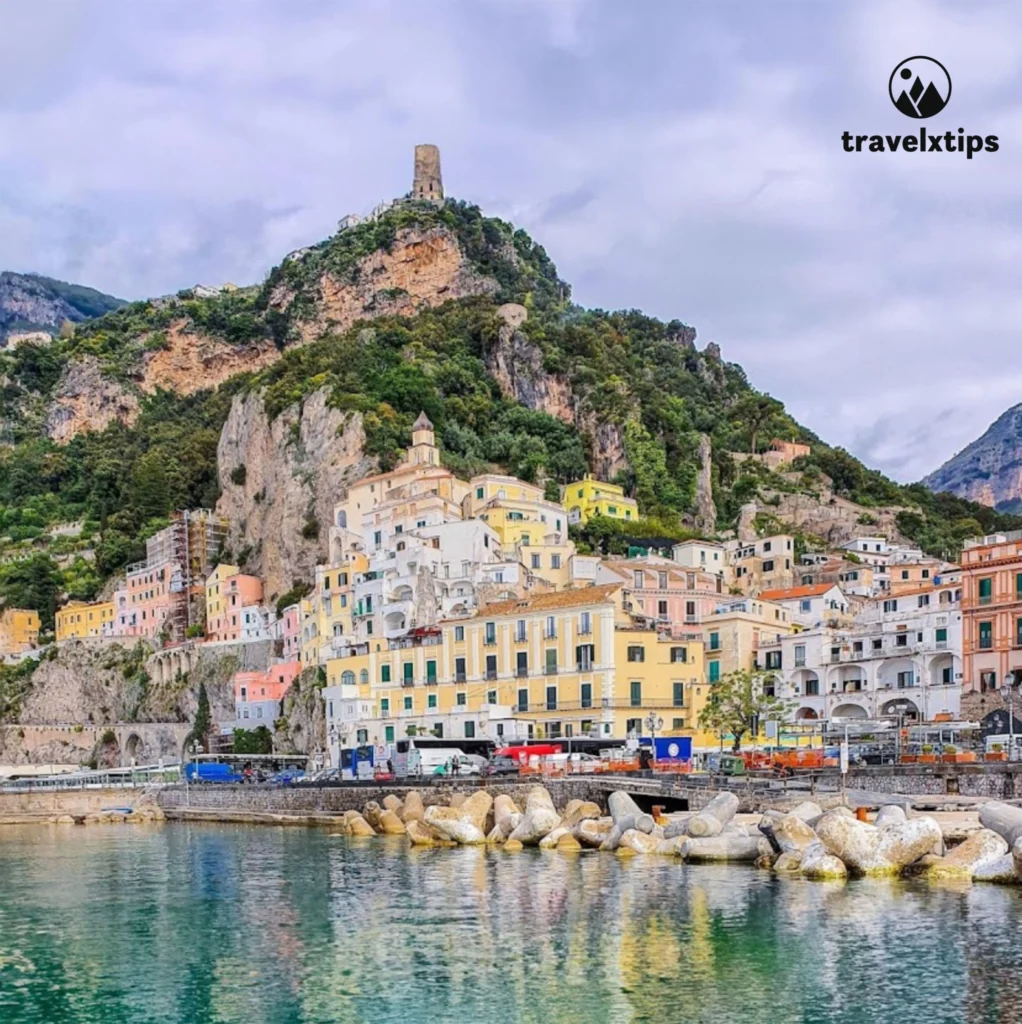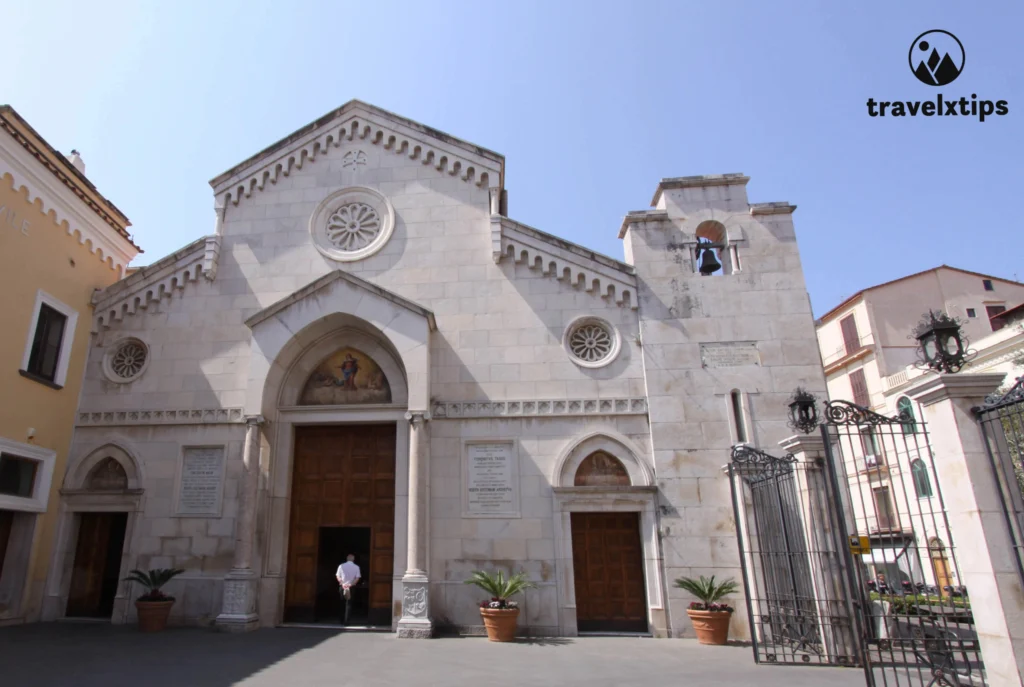Sorrento Italy
Sorrento is a lovely coastal town found mostly in south Italy. It is perched on cliffs above the Bay of Naples. The scenic allure, lively culture, and fabulous food of Sorrento are truly to die for. It is a gateway to the Amalfi Coast, Capri, and Pompeii. A marriage of scenic beauty and historical aura makes it a great destination. Absorb the zestful atmosphere as you meander around the charming cobbled streets that lead away from scenic piazzas, centuries-old churches, and busy little marinas all scented with lemons: so evocative of Sorrento’s famous citrus heritage. Also, its lively atmosphere, delicious cuisine, and perfect location draw visitors to explore the Amalfi Coast, Capri, and Pompeii. With its warm hospitality and eternal charm, Sorrento envelopes the very essence of coastal Italy.

Places to visit in Sorrento Italy
Sorrento has many beautiful places to visit some of which are:
Spiaggia di Sorrento
The beautiful Beach is central in Sorrento, Italy. It is famous for its direct access and the presence of minimarts for those who do not want to carry their food. Apart from that, the picturesque view over Naples Bay and adjacent Capri makes this Beach more than just a place to visit, like Kelingking Beach in Nusa Penida. As a golden sonata with endless waves gently kissing the shore, it provides a perfect basis for sunbathing, swimming, and peaceful sea days. Families, couples, and solo travelers are provided with comforts in it.

Spiaggia di Sorrento has grown into this amazing crescendo of bars and restaurants serving delicious local dishes, from freshly caught fish to classic Italian. The lively atmosphere lets you mingle with locals and travelers while enjoying the sun and waves. The Beach offers plenty of adventure activities as well, including paddleboarding and jet skiing, including world-class views along the coasts
Villa Comunale di Sorrento
Whether you visit during the day or enjoy the evening, this is undoubtedly one of the most romantic spots in Sorrento. The nearby Church and Cloisters of San Francesco often host weddings, adding to the charm. The church’s entrance is conveniently located next to the park. As you step inside and head to the left, you’ll discover a handy feature—the Sorrento Lift, which provides easy access to Marina Piccola and its beach clubs. Also, you can take the scenic pathway down to the marina near the sea-view terrace.

The garden’s main attraction is its stunning lookout point, which offers unparalleled views of the Tyrrhenian Sea. Popular for its serene atmosphere, the park is favored for couples and evening strolls. Nearby, the Church and Cloisters of San Francesco add a touch of romance with their frequent wedding ceremonies
The park occasionally hosts art exhibitions and cultural events, adding to its allure. When you’re ready for a break, you can relax at the La Villa Ristobar, which offers refreshments and dining with breathtaking views of the Gulf of Naples.
Vallone dei Mulini
Vallone dei Mulini, which is also known as Valle dei Mulini or Valley of the Mills. It is a historic landmark in Sorrento. It is a natural, lush valley that houses the ruins of old mills and other structures, providing visitors with a glimpse of the past amidst a scenic environment. The Vallone dei Mulini dates back to around the 13th Century. It gets its name from the presence of ancient flour mills that operated in the valley. These mills served the local population by grinding wheat into flour.
This valley was home to numerous mills, all of which struggled due to the challenging working conditions in the flour mills and other industries that emerged shortly after, thanks to the well-known water supply flowing through the area. A sawmill was established to provide timber for local cabinet-makers, and a washhouse was created for the convenience of women, allowing them to wash and maintain their cleanliness

However, with the arrival of newer flour mills in the vicinity, the valley’s industrial center began to decline. The 1940s shut down the buildings, resulting in their disrepair. Over time, structures deteriorated as weather eroded them, and nature reclaimed the abandoned areas. It allows plants to thrive over the remnants of The Valley of the Mills.
Leonelli’s Beach
Leonelli’s Beach is a historical bathing establishment that Leonelli’s family has managed for three generations. It is located in Sorrento in the center of a wonderful natural bay from which it is possible to admire the magnificent views of Naples and Vesuvius. The beautiful cove surrounded by cliffs and lush vegetation is where you’ll find Leonelli’s Beach, also known as “Bagni Leonelli.” The turquoise waters of the Tyrrhenian Sea create a mesmerizing backdrop, making it a great spot for photography and relaxation.
The Beach has very good amenities such as lounge chairs, beach umbrellas, changing rooms, and showers. There are some private beach clubs and others free ones, which help satisfy diverse tastes and budgets. Beach bars and restaurants offer tempting local dishes and refreshing drinks. Terraces and solariums are furnished with deckchairs and sunbeds, and in other places, guests have beach umbrellas. With stairways leading directly into the sea, one can relax comfortably, tanning and enjoying the utmost privacy.
It’s perfect for families with young children and novice swimmers seeking a safe, calm sea. Leonelli’s Beach is easy to reach from downtown Sorrento. To it, you can either take a walk down the steps or take a quick car ride from Marina Piccola.
Bagni Salvatore
Bagni Salvatore is one of the many charming beach clubs in Italy, in this case, found in Sorrento. These beaches boast a historic atmosphere, clear waters, and genuine Italian hospitality. The view is nothing less than superb from these wooden platforms over water.
Bagni Salvatore is located near the ancient Roman ruins of the Villa di Pollio Felice, often referred to as the “Bagni della Regina Giovanna.” This proximity adds a touch of history to your beach day, with Roman columns and remnants visible underwater during a swim or snorkel. The waters around Bagni Salvatore are incredibly clear, making it an excellent spot for swimming and snorkeling.
Snorkelers often enjoy exploring the underwater ruins and the vibrant marine life. Changing rooms, showers, and restrooms are available there, which makes it comfortable. Also, boats are available for rent for exploring nearby areas like Marina Piccola, Piazza Tasso, and Chiostro di San Francesco
Chiostro di San Francesco
The cloister offers a peaceful escape from Sorrento’s busy streets, showcasing historic architecture, soothing songs, and a centuries-old history adored by tourists. Situated just behind the little Villa Comunale, it is a stone’s throw from Piazza Tasso. In the 14th Century, it was part of the Church of St. Francis and served as a Franciscan monastery. The architecture blends Arab, Gothic, and Renaissance styles, reflecting Sorrento’s rich culture.
Graceful interlaced arches, a series of stout columns of varying materials, include those supposedly salvaged from older Roman and pagan constructions. The central courtyard appears to be a green field with the bright colors of flowers and climbing plants adorning it to please the observer. A spot exuding peace, it is a favorite with contemplative people and painters. It is yet another of the favorite wedding sites in Sorrento, famed for its romantic and picturesque milieu. In addition, it is a popular venue for holding cultural events, such as art exhibitions and classical music performances.
Cathedral of Saints Philip and James
Sorrento’s very own Cathedral of Saints Philip and James stands proudly as a Roman Catholic Cathedral that dates back to the 11th Century. Altered and restored over the centuries, the church reached its grand finishing touch in the 15th Century. This cathedral honors St. Philip and St. James, two apostles of Jesus. It plays a significant role in the history of the Archdiocese of Sorrento-Castellammare di Stabia, as well as in the spiritual and cultural life of Sorrento.

The intricately designed late neo-Gothic facade features a Romanesque-style bell tower elegantly adorned with local ceramic decorations. Inside, Baroque frescoes adorn the ceilings, while the chapels showcase a variety of designs and decorations that contrast beautifully with the choir’s woodwork and the marble pulpit, both masterfully sculpted in the 16th and 17th centuries.
Among other notable features are 6th-century frescoes, a beautifully carved high altar, and an inlaid marble floor, with the ceiling depicting Biblical scenes with remarkable fidelity. The poet Torquato Tasso was baptized at this place in 1544, using an old baptismal font. The chapel houses significant works of art and relics. The bell tower, built in sections, incorporates parts of Roman ruins that are still visible at its base.
How do you get to Sorrento?
Getting to Sorrento is easy, you can get to Sorrento in three ways.
Train
If you want to get to Sorrento by train, you must take the Circumvesuviana train from Naples Garibaldi Station to Sorrento. It takes around an hour to reach Sorrento. During peak travel times, the train gets crowded and is relatively affordable for travelers. Consider the Campania Express, a tourist train with air conditioning for a more comfortable ride.
Car
Reaching Sorrento by car is easy and scenic. If you’re coming from Naples take the A3 Autostrada in the direction of Salerno, then exit at Castellammare di Stabia, following signs for Sorrento and the SS145. Continue on the winding coastal road (SS145) that takes you through towns like Meta, Piano di Sorrento, and Sant’Agnello before reaching Sorrento. It takes around 1 hour to reach Sorrento from Naples.
By Air
To get to Sorrento by air, the most convenient option is to fly to Naples International Airport (NAP), which is the closest airport to Sorrento. From there, you’ll need to continue your journey to Sorrento using other modes of transportation, as there is no airport in Sorrento itself. Use Skyscanner to search for flights to Naples International Airport (NAP). Skyscanner allows you to compare prices from various airlines, find the best deals, and customize your search based on budget, dates, and preferred airlines. If direct flights to Naples aren’t available, consider flying to Rome (FCO) or Milan (MXP) and connecting to Naples by a domestic flight or train.
Important tips for driving to Sorrento
- The roads are congested, especially during summer or weekends. Try to travel early in the morning or late in the evening.
- Look for hotels or parking garages that offer reserved parking. In high season, public parking can be a limitation.
- Italian authorities impose strict penalties and fines are common for cars parked in unauthorized spots.
- Fuel up before starting your trip, as gas stations may be sparse on certain routes. Rest stops along the motorways often provide snacks and clean restrooms.
- Rain can make roads slippery, especially on the coastal route. Check the forecast and drive cautiously during bad weather.
- If you’re hesitant about driving the entire route, consider parking in a nearby town like Castellammare di Stabia and taking a train or bus to Sorrento.






